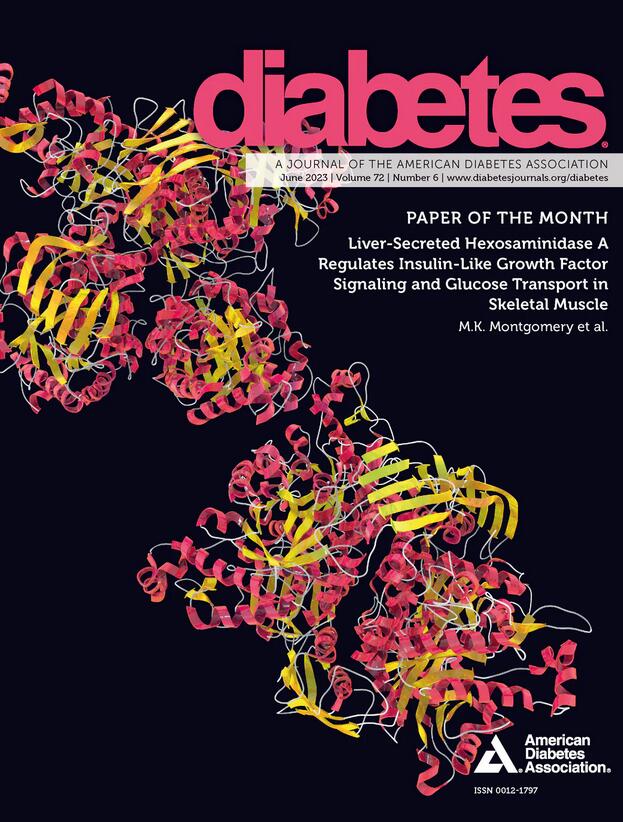应激反应蛋白 REDD1 在荚膜细胞中的特异性表达是糖尿病诱导的荚膜细胞减少症的必要条件
IF 6.2
1区 医学
Q1 ENDOCRINOLOGY & METABOLISM
引用次数: 0
摘要
糖尿病肾病(DN)是终末期肾病的主要病因,但目前还缺乏完全针对其分子病因的有效治疗方法。先前的研究证实,应激反应蛋白 REDD1(发育和 DNA 损伤调控蛋白 1)有助于糖尿病并发症的发生。本研究调查了 REDD1 在荚膜细胞中的表达在糖尿病诱导的荚膜细胞丢失和肾小球滤过功能受损中的潜在作用。在链脲佐菌素(STZ)诱导的糖尿病小鼠体内,荚膜特异性 REDD1 基因缺失可保护肾脏免受损伤,这体现在白蛋白尿、肾小球肥大和系膜基质沉积的减少上。荚膜特异性 REDD1 的表达是糖尿病诱导的裂隙隔膜蛋白 podocin 和肾素减少所必需的。值得注意的是,荚膜特异性 REDD1 基因缺失可防止荚膜细胞减少,并保护糖尿病小鼠的肾小球基底膜和足突结构。在糖尿病小鼠的肾脏和暴露于高血糖条件下的人类荚膜细胞培养物中,REDD1 是瞬时受体电位 6(TRPC6)通道表达增加的必要条件。更具体地说,在高血糖条件下,REDD1 促进了 TRPC6 的 NF-κB 依赖性转录、细胞内钙进入和细胞骨架重塑。总之,这些研究结果为了解荚膜特异性 REDD1 表达在肾脏病理学中的作用提供了新的视角,并支持了靶向荚膜细胞中 REDD1 的疗法对 DN 有益的可能性。本文章由计算机程序翻译,如有差异,请以英文原文为准。
Podocyte-Specific Expression of the Stress Response Protein REDD1 is Necessary for Diabetes-induced Podocytopenia
Diabetic nephropathy (DN) is the leading cause of end-stage renal disease and effective treatment modalities that fully address its molecular etiology are lacking. Prior studies support that the stress response protein REDD1 (Regulated in Development and DNA Damage 1) contributes to the development of diabetic complications. This study investigated a potential role for REDD1 expression in podocytes in diabetes-induced podocyte loss and compromised glomerular filtration. Podocyte-specific REDD1 deletion protected against renal injury, as evidenced by reduced albuminuria, glomerular hypertrophy, and mesangial matrix deposition in streptozotocin (STZ)-induced diabetic mice. Podocyte-specific REDD1 expression was required for diabetes-induced reduction in slit diaphragm (SD) proteins podocin and nephrin. Notably, podocyte-specific REDD1 deletion protected against podocytopenia and preserved glomerular basement membrane and foot process architecture in diabetic mice. In the kidneys of diabetic mice and in human podocyte cultures exposed to hyperglycemic conditions, REDD1 was necessary for increased expression of the transient receptor potential canonical 6 (TRPC6) channel. More specifically, REDD1 promoted NF-κB-dependent transcription of TRPC6, intracellular calcium entry, and cytoskeletal remodeling under hyperglycemic conditions. Overall, the findings provide new insight into the role of podocyte-specific REDD1 expression in renal pathology and support the possibility that therapeutics targeting REDD1 in podocytes could be beneficial for DN.
求助全文
通过发布文献求助,成功后即可免费获取论文全文。
去求助
来源期刊

Diabetes
医学-内分泌学与代谢
CiteScore
12.50
自引率
2.60%
发文量
1968
审稿时长
1 months
期刊介绍:
Diabetes is a scientific journal that publishes original research exploring the physiological and pathophysiological aspects of diabetes mellitus. We encourage submissions of manuscripts pertaining to laboratory, animal, or human research, covering a wide range of topics. Our primary focus is on investigative reports investigating various aspects such as the development and progression of diabetes, along with its associated complications. We also welcome studies delving into normal and pathological pancreatic islet function and intermediary metabolism, as well as exploring the mechanisms of drug and hormone action from a pharmacological perspective. Additionally, we encourage submissions that delve into the biochemical and molecular aspects of both normal and abnormal biological processes.
However, it is important to note that we do not publish studies relating to diabetes education or the application of accepted therapeutic and diagnostic approaches to patients with diabetes mellitus. Our aim is to provide a platform for research that contributes to advancing our understanding of the underlying mechanisms and processes of diabetes.
 求助内容:
求助内容: 应助结果提醒方式:
应助结果提醒方式:


